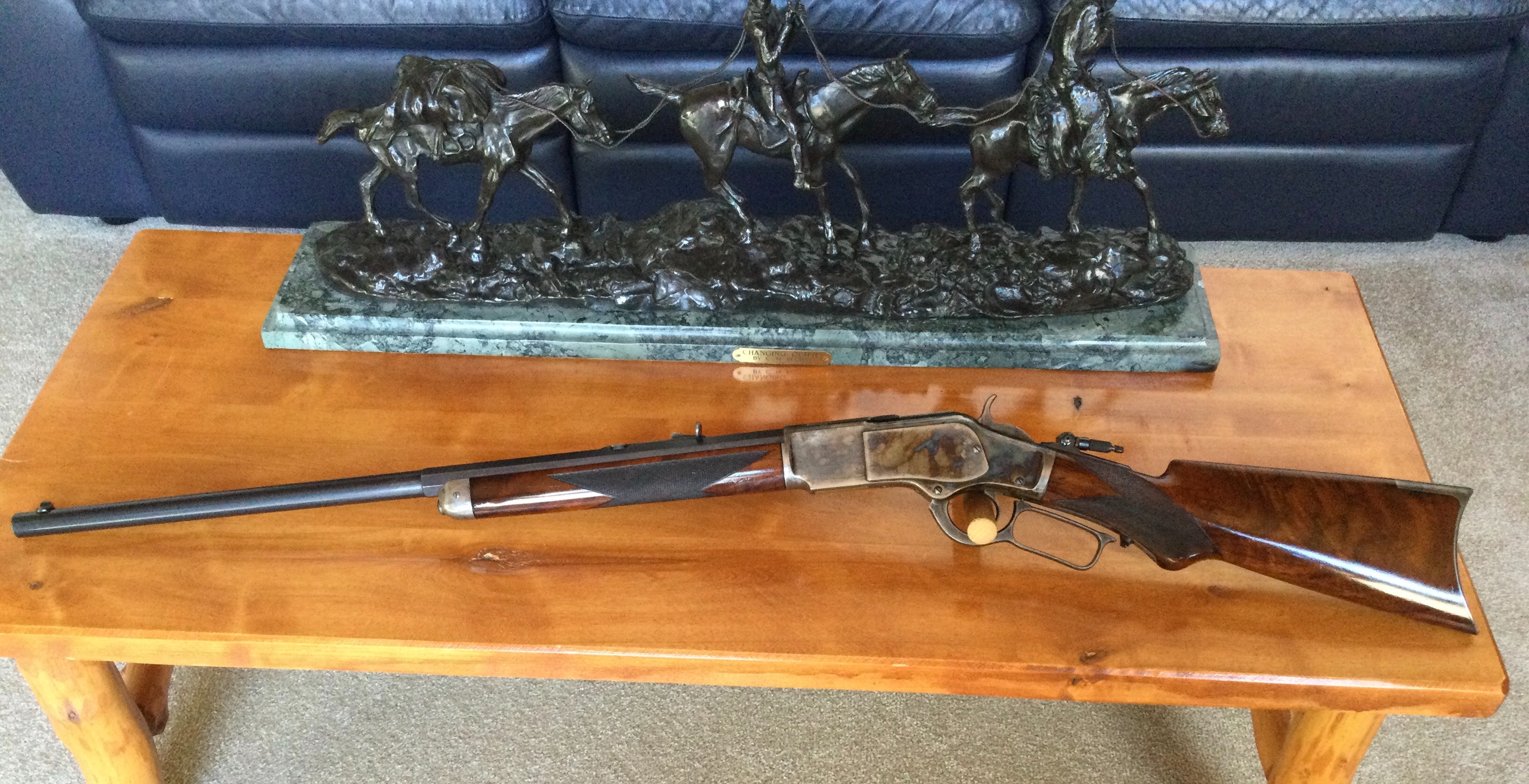January 31, 2008
 Offline
OfflineI happened to come this 86 Winchester 45-70 on Gunbroker….it looks good but the paperwork from Cody says nothing about X or XX wood which is assumed by the seller. I think it’s a better than standard piece of wood but not X or XX. What do you think ?
https://www.gunbroker.com/item/959183412














September 22, 2011
 Offline
OfflineIf not original to that rifle, the wood has been on it a very long time.
There is possibly a gap on the right side between the frame and the receiver, but I would really like to see this rifle in person before I could conclude that this is problematic or just an optical illusion.
May 23, 2009
 Offline
OfflineI agree that while it is slightly figured wood, it is not X grade quality wood in my opinion.
Sincerely,
Maverick
![]()
WACA #8783 - Checkout my Reloading Tool Survey!
https://winchestercollector.org/forum/winchester-research-surveys/winchester-reloading-tool-survey/
December 26, 2017
 Offline
OfflineI saw this gun online the other day and my first thought was that stock is not like any I have seen before. It sure looks like a factory made stock. Winchester knew what they were doing and would not normally use wood like that. The odd grain in the front would not be nearly a strong as the always seen straight grain. It certainly is unusable enough to raise questions.
THIS ALL STARTED WITH JUST ONE GUN!
February 17, 2022
 Offline
OfflineHave you pulled the stock and checked for any assembly numbers on the tang? I own several 86’s and generally find that there will be x stamps in the tang for matching the higher graded wood. But with that being said all of mine that have high grade wood letter as such, but never know til you look.
March 31, 2009
 Online
OnlineWinchester used all the wood they had and sometimes stocks like this were made and kept for guns that were ordered with special features but were not fancy and checkered. I have had a couple with nicer wood but not an X. The installers grabbed wood from a regular wood bin and weren’t usually concerned what it looked like but usually tried to match the stock with the forend. Here is an 1893 I have. These are my notes on this gun. “Letter does not mention wood. The butt stock and forend are a much nicer than normal grade of wood. On the underside of the butt plate there are two S’s, an 11, a 10 and an 0. On the receiver end of the butt stock there is a 10. On the butt end of the receiver there is a 10. On the metal shaft that extends into the butt stock there is an S”.
Letter does say “Close Shooter” in the comments.


April 1, 2005
 Offline
OfflineI don’t disagree with any comments which have been made. However, the wood is just not what you would normally see on a standard grade Model 1886 of this vintage and the forearm wood is just not as good/highly figured as the buttstock. A long, long time ago an old time collector told me that “if the mane and tail don’t match, it is best to pass” and I personally would pass on this one and avoid the criticism.

November 17, 2011
 Offline
OfflineMy understanding of stock making is that it all comes from the same piece of wood as to carry the symmetry of the grain forward.
Any proof of this statement? It would be incredibly difficult to keep a butt stock and forearm made from the same blank together during the mfg. process. I often see noticeably different colors on the two pieces. They were made from different pieces of wood and they age differently is my view.
April 1, 2005
 Offline
OfflineBurt Humphrey said
I don’t disagree with any comments which have been made. However, the wood is just not what you would normally see on a standard grade Model 1886 of this vintage and the forearm wood is just not as good/highly figured as the buttstock. A long, long time ago an old time collector told me that “if the mane and tail don’t match, it is best to pass” and I personally would pass on this one and avoid the criticism.
After looking at this gun on the Gunbroker site where there are 131 really good photos as opposed to just a few here on the Forum post, I have totally changed my mind on this gun. There was never any doubt about the wood being on the gun for a long time and now after looking at all the photos, I think forever. I now think the butt stock wood and forearm are actually a pretty good match with respect to grain, color and condition. It is better wood than what is normally found on a standard grade Model 1886 but as others have noted, it is not “x” wood. However, nicer than any that was ever on a standard grade 86 which I owned.


March 31, 2009
 Online
OnlineI know that modern gun restorers use the same piece of wood for the stock and forend. I have a lot of the cutoffs from Roger’s shop. I don’t know what Winchester did for regular stocks and forends? The fancy wood had an assembly number on each piece as well as the gun and butt plate. Maybe the select wood was separated too?
Here is a picture of an 1873 I once owned. It had a longer than standard barrel, set trigger and an ivory front sight. The sight did not letter and there was no mention of the grade of wood. Randy Saba bought this and I’m sure sold it soon after.


1 Guest(s)


 Log In
Log In







